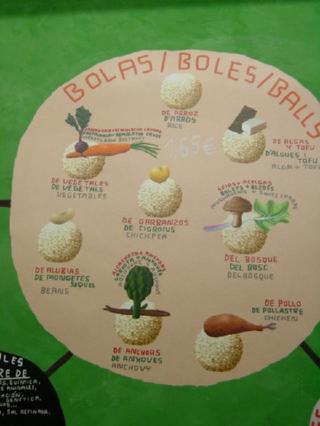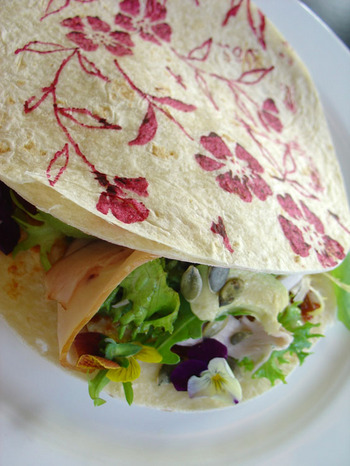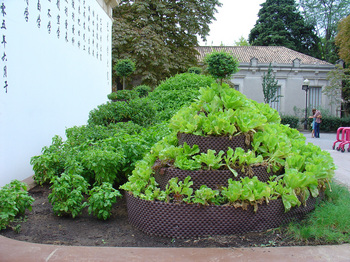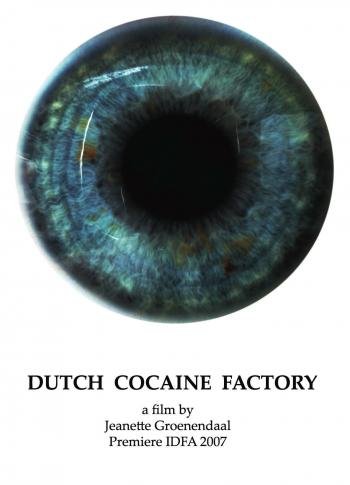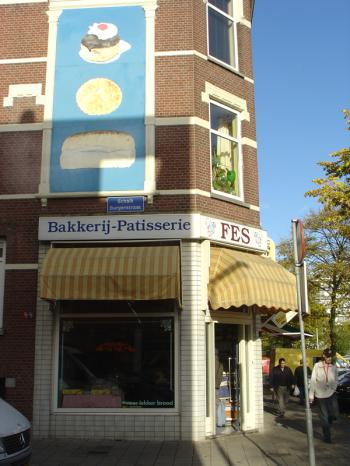Food-related film at the 4th Berlinale Talent Campus
February 23, 2006

‘Doña Ana’, watercolour and collage that inspired Marlon Vasquez Silva’s animation film Strawberry Eating Woman. ‘Doña Ana’ © Marlon Vasquez Silva, digital image courtesy of the artist
Apparently the director of the Berlinale International Film Festival, Dieter Kosslick, is obsessed with food and cooking. This explains why one of the six programmes had as its theme Food, Hunger and Taste. The 4th edition of the Berlinale Talent Campus (BTC), a section for young-ish filmmakers (when young means under 40), was dedicated to a heavily-worked relationship between food and film. Aside from my interest in the subjects, this was the most coherent and well-organised programme within the Berlinale. The Talent Campus offered young filmmakers a chance to meet, show their films, attend presentations, workshops and in general become indoctrinated I mean introduced to the film industry.
Although the evenings’ big-screens at the BTC lamentably included worn out choices of food-related film like Babette’s Feast, Eat Drink Man Woman, (how to ruin great films with unimaginative programming) and the dreaded ‘Food + Romantic Comedy’ genre piece, ‘Bella Martha’ by Sandra Nettelbeck, the programmers were wise enough to screen historical gems like Marcel Pagnol’s ‘Harvest (Regain)’, informative documentaries like Hal Erickson’s ‘Alice Waters and her Delicious Revolution’ (2003) and the most sensual cinematic food chain and materials exploration ever made, ‘Drawing Restraint 9′ by Matthew Barney.
This year, thirty-two young filmmakers were spotlighted in the Berlinale Talent Campus and divided into a five part programme titled unoriginally, ‘Food for Thought’. From the selection, the films on the subject of hunger tended to suffer most from ill-research and moralist pedantics.
But when the films were good, they were very very good. Here is the culiblog selection of the eight best films on Food, Hunger and Taste from this year’s Berlinale Talent Campus (in alphabetical order):
- A LOVE SUPREME. Nilesh Patel, UK: A hyper-rhythmic black and white short supposedly inspired by Raging Bull, but I see it as a sexy visualisation of a samosa recipe. I love the film’s changing sense of time, concentrated detail shots and the stolen moments of materials pleasure. Bravo.
- CAKE IN THE FACE. Katarina Hellberg, Sweden: At a Talent Campus laden with moralistic expressions, one of the most refreshingly humorous films was Hellberg’s CAKE IN THE FACE. Hellberg interviews the head of the international ‘pie-ing’ movement, who says, ‘Every time I pie someone it is a total orgasm.’ The international movement throws soft cream pies in the faces of the offensively powerful as a political expression. This film is indicative of the acitivist undercurrent in the world of food at the moment, and would programme well alongside feature length documentaries. It offers the audience a light-hearted answer to combat the gloom that is the contemporary food and agriculture documentary.
- It is noteworthy that of all the BTC short films, only those dealing with pies and cakes were funny. Short pause for thought.
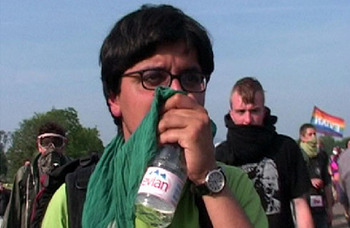
EviannaÏve image still © Verena Vargas, used courtesy of e|x|il Film
- EVIANNAÏVE. Verena Vargas, Germany: Lengthy but good, but lengthy. Eviannaïve documents a group of activists as they travel by train from Berlin to a small town near Geneva to disrupt the 2004 meeting of the G8. Civil disobediance and youthful enthusiasm are their only weapons. The title’s palindrome hints at how difficult it is for the anarchists to mobilise politically, but somehow they do. (Maintaining the values of civil disobedience in the face of violent police action is not for the faint of heart.) It’s the hippy in me that can’t help but identify with activists that pick up their trash upon returning from the demo. This is a worthy historical document, lengthy, but good. But lengthy.The Eviannaïve website
- HUNGER. Maia Burduli, Georgia: Shrieking babies, tightly bundled up in blankets. One is worried that a fumbling nurse, insisting on carrying three newborns at a time, will drop one on its noggin. Ms. Burduli exlained after the screening that in Georgia, a baby’s screams for its first mouthful of breast milk is a positive thing, a sign of thriving. In the film, once the nipples show up, we see what babies and mamas see, right up close and personal. Intense sucking is followed by a blissed-out milk coma.
- LA VIDA DULCE. Rouven Rech, Germany: An almost slapstick documetary short about Cuban subsidised cake distribution. If you’re a Cuban mother on Mother’s Day, you will get yer dang cake. After watching the short several times, it still confounds me that even though cake boxes are used in the transport of these generously frosted creations, no one puts the cake in the box, preferring instead to keep it on display, exposing the cake to all manner of dangers. Hilarious and sweet.
- STRAWBERRY EATING WOMAN. Marlon Vasquez Silva, Colombia: This was by far the most unique film of the BTC, an animation comprised of beautifully created watercolours and collages addressing the plight of displaced farmers in Colombia. Without being overtly political, Strawberry Eating Woman lays bare the loss of cultural capital that occurs when small agricultural communities are destroyed. Surprising and refreshing, like an excellent little strawberry.
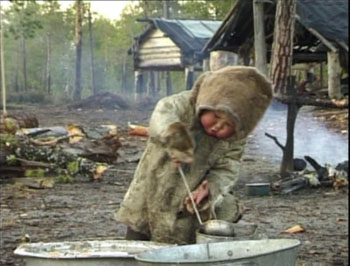
Tiny Katerina serves food to the dogs, image still © Ivan Golovnev, used courtesy of Golvnev Film
- TINY KATERINA. Ivan Golovnev, Russian Federation: Golonev admits readily that Tiny Katerina is a film about changing lifestyle more than about food. It documents the youngest member of a Northwest Siberian family that lives in a felt tent in near isolation. Katerina can’t be more than two years old, but it is confusing whether she is playing at being an adult or is actually participating in the rigourous family chores! We see her lugging blocks of firewood around and cooking for the family’s dogs. Two years old! Golovnev’s camera is completely unobserved, offering an intimate view of a life that will soon vanish in the petrol politics currently plaguing this region. The documentary short has a distrubing ending that places the film within a larger political context.
- WASTE NOT, WANT NOT (CHICKEN A LA CARTE) Ferdinand DeMadura, Philippines: Just because I included this film on my list does not mean that I liked it. But Chicken a la Carte’s subject has deeply interested me ever since I encountered it in PRChina: food-recycling. DeMadura follows a supply chain in which food travels from an urban food court in Anywhereville, South East Asia, to the kitchen where waste food is sorted, placed in a bag, in a bucket on a bike. I do not like green eggs and ham. Later the recyclist distributes the food amongst village children and the choicest of gleanings land ultimately on the family table of the food-recyclist himself. The practice is widespread all over… everywhere. Better film next time, DeMadura, but chapeau, your subject matter is rivetting.
technorati tags: Berlinale Talent Campus, Berlinale International Film Festival, film, food-related film, cinema, Berlin
debra at 15:25 | Comments (0) | post to del.icio.us
Let the future begin, kimchi air conditioner is here
February 15, 2006
Romantic kimchi photo courtesy of “Do the Bart” Charlotte Yong San Gullach
Kimchi is pickled cabbage (or radish or mustard leaf or…) and I feel quite comfortable in reporting that it is one of the top five most delicious things you can put in your mouth. It is Gawd’s own comfort food, made with generous amounts of fresh garlic, ginger and red peppers, it is crazy healthy. So healthy, that an entire nation and a large population of several other nations believe that kimchi can prevent illness. I belong to one of those nations. Kimchi Nation. Kimchi also has a farty smell, but regular culiblog readers know that I just live for that.
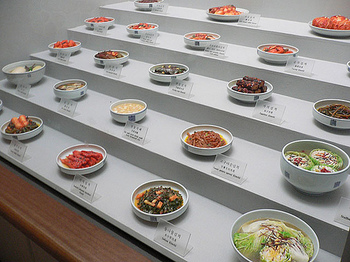
Museum of Kimchi photo courtesy of NihaoGirl
And if all that weren’t reason enough to get a leg up on the kimchi altar, apparently kimchi can also kill the avian flu virus H5N1 and is soon to be used in the manufacture of air conditioners. No Fred, not hair conditioners, AIR conditioners.
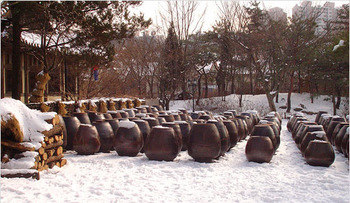
Snowy vats of kimchi fermenting in the park courtesy of Polish Sausage Queen
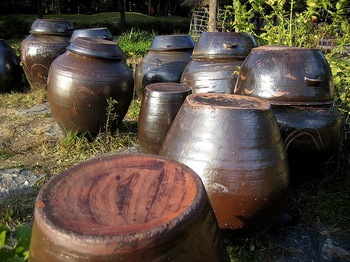
Kimchi pots in the public space by Bryan Hughes
Unfortunately the air conditioners will use only the enzyme from the kimchi and will not transmit its smell. This is a mistake waiting to happen and I would like to urge you to get on the horn immédiatement to let LG Electronics know how wrong that would be.
Thank you Willem for this culi tip. You know I love the kimchi.
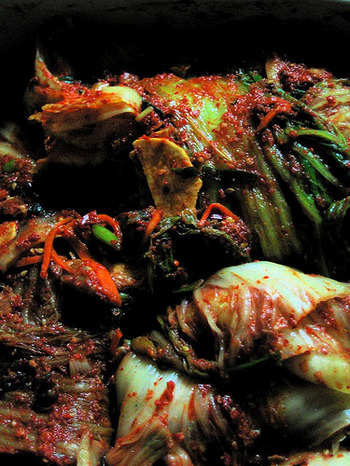
Glamour shot of kimchi courtesy of a person with wonderful photographic skills and whose name I cannot read because it is written in Korean
A list of links to images and air condioner manufacturers for Kimchi researchers and cultural activists.
- culiblog writes about kimchi
- Reuters on the Kimchi air conditioner
- Flickr kimchi tag
- LG Electronics online contact form in Dutch
- Romantic kimchi photo courtesy of “Do the Bart” Charlotte Yong San Gullach
- Museum of Kimchi photo courtesy of NihaoGirl
- Snowy vats of kimchi fermenting in the park courtesy of Polish Sausage Queen
- Kimchi pots in the public space by Bryan Hughes
- Glamour shot of kimchi courtesy of a person with wonderful photographic skills and whose name I cannot read because it is written in Korean
technorati tags: kimchi, avianflu, South Korea

Kimchi, the comfort food of the gawds courtesy of culiblog
debra at 23:58 | Comments (10) | post to del.icio.us
When fish fall in love
February 13, 2006
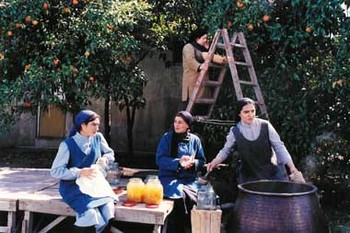
film still from When Fish Fall in Love, shows main character Atieh, her daughter and sisters preparing orange syrup in the garden. Image used without permission
When it comes to food-related film, I couldn’t have made a better start at the Rotterdam International Film Festival. Drawing Restraint 9 had me reeling for days. Good for Drawing Restraint, bad for all the others that I saw directly afterwards. I had all but given up hope for finding a new approach to the genre, when I went to see the last film on my list.
When Fish Fall in Love saved me from being mired in bourgeois feel-good movies, films that are little more than romantic comedies with chefs and kitchens, gratuitous food porn, films that make audiences twitter at the thought of eating bull’s testicles. Fish Fall in Love is Iranian theatre director Ali Raffi’i’s first feature about two lovers being reunited after a twenty-year separation, and a new generation of about-to-be lovers, about to be separated.
Ex-political prisoner and Iranian émigré Aziz returns to his home at a Caspian Sea coastal village, where he finds that his former beloved Atieh, her daughter and two sisters have appropriated his family home and turned it into a restaurant. The film is shot like an old postcard from your grandparents’ seaside holiday, complete with long images of regional specialities. In this film, no dish leaves the kitchen without making a cameo. Can you imagine jewelled rice doing the red-carpet walk at Cannes?
Ali Raffi’i spoke to the audience before the screening, explaining that this film was about the difference between the way his and the generation now in their twenties, express love for one another. His intricately developed characters convey the complicated situation of a generation (Aziz and Atieh) whose political passion (may have necessarily) precedes their passion for each other. This contrasts sharply with the generation of Atieh’s daughter Touka and her Teheran beloved Reza, who are even driven to criminal acts in the hope of supporting their love.
Admirably, Raffi’i endeavoured to show a different view of woman than what he described as ‘ordinarily portrayed in Iranian cinema’; a woman whose destiny is not dependent on the presence or hope for presence of a man in her life. Not being sufficiently familiar with Iranian cinema to judge, I had to think, ‘Heq, come on over here, that’s a hole in the market!’ Until now, the art installation videos of Shirin Neshat and the British documentary filmmaker Kim Longinotto’s Divorce Iranian Style were until now, my sole influences.
While Atieh is a strong character, supporting her daughter, two of her sisters and herself by running a small restaurant, she is also always really nervous about this role. Preparing lunch and dinner for only twenty, though she’s been doing it for years, seems to be a monumental feat for her. Among the many kitchen shots of brilliantly presented ‘home-style’ cooking, the viewer is treated to beads of sweat on noses and upper lips, the wiping off of sweat from brows and the drenched backs of clothing. I’m thinking, ‘Sister, what you need is a smaller menu.’ But Atieh’s unwieldy menu seems to represent traditional culture and her uncomfortable relationship with it.
The film’s ending is deliciously open, giving few clues as to how Aziz and Atieh will give shape to their deep love and respect for one another in the future.This combined with Raffi’i’s rich characters have given me room to identify completely with love’s consequences for Atieh and Aziz. All that I am willing to give away, is that there is a cottage involved. I know that the next time I make orange syrup, this film will be the first thing on my mind.
- Film review of When Fish Fall in Love on Teheran Avenue
- Iranian Food Photos on Flickr
- Film Festival Rotterdam entry about When Fish Fall in Love
- Forget Martha’s Vineyard, I’m going to Iran
- Women Make Movies on Kim Longinotto
- About Ali Rafi’i as a theatre director
technorati tags: International Film Festival Rotterdam, film, food-related film, cinema, Rotterdam, When Fish Fall in Love, Ali Rafi’i
debra at 14:01 | Comments (0) | post to del.icio.us

